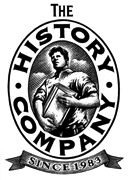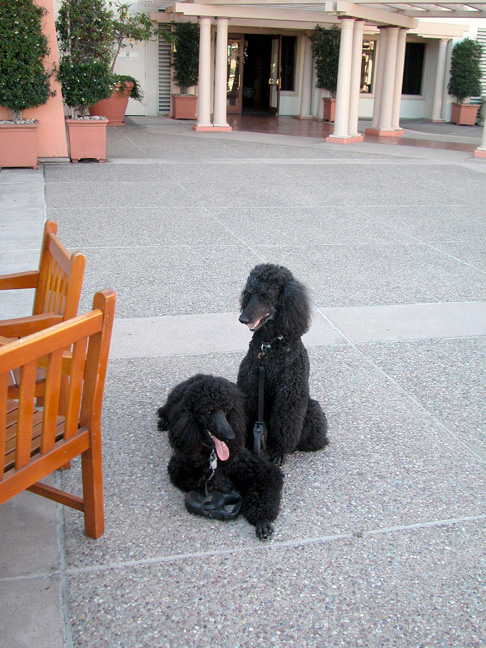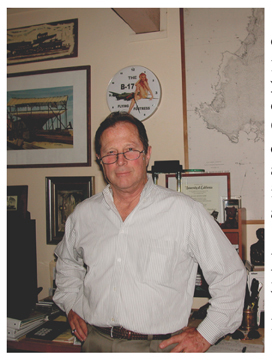
The History Company Staff
2005
Meet (Texan) Charles Devin ("Charlie")
and
Simone (Sidney, Australia).
Simone is the Queen of Haiku Plantations, Oahu, Hawaii,
Carmel-By-The-Sea and Carmel Highlands, California—and now Carmel Valley.
They are not related. The only thing they have in common (other than Champion lines)
is that they bark with accents...
This photo is at a Staff Meeting at the Monterey Plaza Hotel & Spa on Cannery Row,
Monterey, California. The History Company would not function without them.

Staff 2006
Simone with Charlie Devin's honorable successor, Devin Charles Wolfson-Hemp (Marin County).
Carmel Valley staff meeting.

2007 saw the addition of a new staff member, Sheba Wolfson-Hemp.

...and then there is
Back
Simone is the Queen of Haiku Plantations, Oahu, Hawaii,
Carmel-By-The-Sea and Carmel Highlands, California—and now Carmel Valley.
They are not related. The only thing they have in common (other than Champion lines)
is that they bark with accents...
This photo is at a Staff Meeting at the Monterey Plaza Hotel & Spa on Cannery Row,
Monterey, California. The History Company would not function without them.

Staff 2006
Simone with Charlie Devin's honorable successor, Devin Charles Wolfson-Hemp (Marin County).
Carmel Valley staff meeting.

2007 saw the addition of a new staff member, Sheba Wolfson-Hemp.

...and then there is
Michael K. Hemp

Biographical Profile
2011
|
Michael Kenneth Hemp was born in
Berkeley, California, on December 23, 1942. He completed his high
school
education in 1960 as valedictorian of St. Mary's College High School in
Berkeley, attended Gonzaga University in Spokane, Washington, for two
years,
and transferred back home to Berkeley to complete his degree in
International
Relations at the University of California. He left Shell Oil Company
for
military service, commissioned a 2nd Lt. in the United States Air
Force,
serving as a Special Intelligence Officer to three Commanders-In-Chief
of
the Strategic Air Command, Offutt AFB, Omaha, Nebraska. His fourth (and
last) year of military service was based in Thailand, at Nakhon Phanom
RTAFB, operating in Laos,
Cambodia and the Vietnams in Special
Operations. He was discharged from active duty as a Captain in
1970. Michael became a resident of the Monterey Peninsula in 1979, where the author's writing and historical interests brought him into contact with an increasingly large circle of people who had valuable knowledge of the Old Row, John Steinbeck, and Ed Ricketts (the "Doc" of Cannery Row). And so began the "typical journalistic account of Cannery Row since Steinbeck" so often attempted by other writers similarly swept into the mystique and magic of Cannery Row's tragic history and romantic Steinbeck spell. However, unlike most other writers interested in Cannery Row [primarily reporters, travel writers, and visiting literary scribes], living in Monterey made it possible to do more than the cursory interpretation dictated by deadlines and limited visits from out-of-area bases of operations. He was at home on Cannery Row with the time and interest in delving into the tales, facts and fascinating secrets of its colorful past. For almost seven years he owned a small "studio"--actually a dilapidated turn-of-the-century bungalow--above the tracks behind the "Wing Chong Market" made famous in John Steinbeck's "Cannery Row". Ironic as it may seem, in the early 1980s the history of Cannery Row-- the scene of one of our nation's most catastrophic industrial and environmental disasters, and the location of John Steinbeck's world famous fiction--was yet to be fully researched, written and published. Tom Mangelsdorf's fine documental research work was still without a publisher, and no concerted attempt had been made to record the "human history" of the daily work life and conditions through world wars, bootlegging and Prohibition, the Great Depression, and the industrial process that would ironically ensure the commercial extinction of the sardine. Without such a vitally important resource, virtually everything learned about the "human history" of the Old Row, its workers, inhabitants, businesses and canneries--as well as anything about John Steinbeck's tenure on the street--was new and largely unrecorded information. Yet so many surviving cannery workers and fishermen still had pieces of the huge mosaic of Cannery Row history about to be lost to posterity. The history of day-to-day life on old Ocean View Avenue, in pursuit of fishing and canning the ubiquitous Monterey sardine, was a story largely unrecorded by the newspapers or preserved by the historical establishment of the time. Cannery Row was widely viewed as a filthy, smelly, distasteful, immoral blot on the good name of Monterey--even if it did account for most of the commerce and prosperity of much of its business class and social elite. Its "human history," therefore, had to be accomplished face to face with the men and women still alive who knew it by having lived and worked the boats and canneries, to acquire and preserve for posterity the perspective of their frank, unfiltered life remembrances of daily life and labor in an incredible place and time. Journalism, almost entirely involving the magic of John Steinbeck's only slightly fictitious accounts of life on the street in the 1930s, had passed for history. Or so it seemed. But just where were the original canneries? Who built them? What was it like working in them, or on a purse seiner in the pitch dark of night to catch the sardines for the canneries of the Row? Who were the bums Steinbeck wrote about? Was "Doc" Ricketts really like the Steinbeck character or not? Accurate answers to many questions about Cannery Row, its origins, settlement and growth, its nationalities, its fishing and canning history, and John Steinbeck's real experience with the street simply could not yet be made. What do you suppose life and work on Cannery Row at the watermarks of this century's history was like? At the turn of the century when sardines began to replace salmon as the canner's fish of choice; World War I and the explosion of sardine demand as a wartime food staple and ration; the post-war recession that devastated Monterey; the "Roaring Twenties" and Prohibition; bootlegging and bordellos along bawdy Ocean View Avenue [the original name of the street now "Cannery Row"], berated loudly by many of Monterey's staunchest citizens and businessmen, but secretively patronized by many of them as well. And World War II, along with worldwide fame as the "Sardine Capital of the World." Independent research for the answers required an overwhelming amount of time and intensive pursuit of leads to individuals that were qualified, interested and willing to be interviewed. The question then became, "Interviewed for what?" The original interest in John Steinbeck and Ed Ricketts suddenly demanded a broadening to include the preservation of the entire human history of Cannery Row--the context for the Steinbeck-Ricketts research effort. Both the story of Ed Ricketts and John Steinbeck, and the street-level oral history of Cannery Row were in imminent jeopardy of being lost, unrecorded without a concerted effort to acquire and preserve it in appropriate archival form. It was soon evident that even concerted part-time efforts would clearly lose the race against the daily obituaries. A new approach had to be found--and if not already in existence--created. Which is how the Cannery Row Foundation came into being. In the fall of 1982, Michael contacted Monterey attorney Bob Rosenthal to establish a non-profit historic and educational foundation specifically dedicated to research and preservation of the history of Cannery Row. The help of board members like Frank Wright of Carmel [one of the two members of the group that owned Ed Ricketts' lab who actually knew Ed Ricketts], and Eldon Dedini, Max Tadlock, Gengo Sakamoto, Gary Ibsen, Jerome Lucido, Paul Davis, Dick O'Kane, Lou Rudolph, Tracy Call, Don Boston, David Cohen and Bob Rosenthal, made the foundation framework a reality. And into this uncertain and uncharted area of activity, it fell to Michael Hemp--as its Executive Director and Research Historian--to organize, manage, research and raise funds to support the Foundation activities. Most importantly, a research breakthrough to more former cannery workers, fishermen and Steinbeck resources was needed. His solution was to provide a genuine celebration of former cannery workers and fishermen, a reunion, which could help locate additional surviving Cannery Row "Alumni" and encourage the contribution of their stories and information about the Old Row to the Foundation's historical preservation efforts. The first "Great Cannery Row Reunion" was held May 13-15, 1983, at the Monterey Conference Center and the Outrigger Restaurant on Cannery Row [formerly the Monterey Canning Company cannery], and there again in 1984. The reunions of 1985 and 1986 were held at the Monterey Bay Aquarium. The last original reunion was held in December 1987, at the Monterey Plaza Hotel. Insufficient financial support and difficulties in fundraising, in spite of significant historical research accomplishments, dictated the cessation of activities of the Cannery Row Foundation in early 1988. Michael relocated to Koloa/Poipu Beach on the Hawaiian Island of Kauai in February of that year and pursued heritage marketing Hawaiian Style. In its last years of initial operation, even with severe revenue shortages, Michael Hemp had been able to arrange a personally financed publication of his research, "CANNERY ROW, The History of Old Ocean View Avenue." The concept of the book sprang from Michael's pragmatic vision of heritage marketing that dictated a book inexpensive enough to be easily acquired [which meant publication in a soft cover format as opposed to hard cover]; a book attractively yet functionally designed to be read easily and also used as a handbook and guide to Cannery Row; of obvious value to Monterey visitors, residents, students or Steinbeck scholars that wanted to know what the street was really like when sardines were king and John Steinbeck haunted its shanties and canneries--and spent creative time in the company of Edward F. "Doc" Ricketts. The book, first released in May of 1986, quickly became one of Monterey's best selling histories. The book, in its Third Edition, published in 2009, now includes over 200 large format archival photographs reproduced from the Pat Hathaway Historical Photo Collection to provide an important visual understanding of the book's research topics, to clearly illustrate each step in the complex fishing and canning process, and to set the stage for John Steinbeck's Cannery Row fiction. A principal feature of "CANNERY ROW, The History of John Seinbeck's Old Ocean View Avenue" is that it contains the most detailed and authoritative historical and Steinbeck guide to Cannery Row in existence. A two page historical map guide locates and provides additional notations on Ocean View Avenue's historical locations, original cannery sites, and the actual locations in John Steinbeck's Cannery Row fiction. Michael and his wife, Terri Wolfson, [dba Concept Communications, Concept Destinations, Concept Real Estate Services, and The History Company] endured Hurricane Iniki on the Island of Kauai in 1992 and relocated to Oahu. They subsequently returned to the Monterey Peninsula from Hawaii in mid-1995. Michael's heritage marketing and destination marketing experience served the Cannery Row Company as its Director of Marketing, Communications and Special Events for almost eight years, while continuing historical research, writing, and publishing. His wife, Terri Adrienne Wolfson, operates her own professional interior design firm, T. A. Wolfson Design (www.tawolfsondesign.com). They live in Carmel Valley Village with two standard poodles, Sheba and Devin (Michael's "Staff") and a pair of Eclectus parrots, Valentino and Ku`u`ipo. Michael became a novelist in 2008 with the publication of "The Nadjik Pheromone"—a global technothriller based on emerging developments in the science of forensic breath analysis lie detection by GC-MS (Gas Chromatography-Mass Spectrometry), the science so prevalent in all of the "CSI" television series. The book was a finalist in the 2009 Indy Book Awards for Fiction, and a National Best Books Award 2009 fiction finalist. It is an Amazon.com 5-star book and rapidly gaining popularity in scientific and technical circles invloved in GC-MS/LI-MS science. March 2011 marked a return invitation to present "The Nadjik Pheromone" hypothesis again to the American Chemical Society at their conference in Anaheim. Updated information is available at The Nadjik Pheromone Blog. 2011 was a busy year at The History Company as resources were focused to enter the iPhone and iPad Travel App market at iTunes (Apple, Inc) with two premium apps for CANNERY ROW & Waterfront, and CARMEL and CARMEL VALLEY. Each has thousands of original professional, high-resolution (PhotoShoppped) images (none from stock photo vendors), joined by hundreds of Pat Hathaway Collection classic archival "Then and Now"views of the best to see and do in these two storied areas of the world-famous Monterey Peninsula. Both apps launched with instant 5-star iTunes user ratings. And then came the Kindle e-book premier of "SUR, Legend of the Last Otter Hunter." As its Monterey County Weekly headlined its major review, "The Last Otter Hunter tells the story Cannery Row's definitive historian always wanted to tell." Set in Post-Western Monterey and the Central Coast, its origins are reportedly true, collected as part of historical oral histories from Cannery Row in the 1980s. The story is dedicated to Clint Eastwood, whose "Unforgiven" character inspired the personna of its lead character, destined to be the last Big Sur otter hunter. And the year isn't over yet... Michael has two children, a daughter in computer sciences and a son a contracter in green construction. Both are raising grandchildren in adjacent Santa Cruz county. |
09/25/11
Back